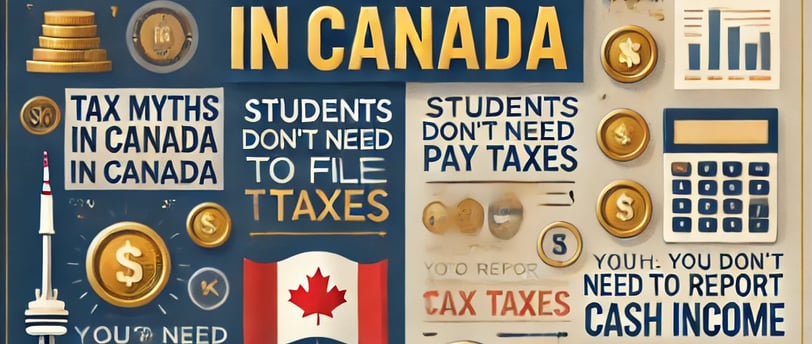Myths About Tax Refunds & Credits in Canada
What You Need to Know
Shihan Haniff
3/20/20253 min read


Tax season in Canada often comes with a flurry of misconceptions about tax refunds and credits. Many Canadians unknowingly believe myths that could either lead them to miss out on valuable tax benefits or create unrealistic expectations. Let’s debunk some of the most common myths surrounding tax refunds and credits.
Myth 1: Everyone Gets a Tax Refund
One of the biggest misconceptions is that everyone is entitled to a tax refund. In reality, a tax refund occurs when you have overpaid your taxes throughout the year, either through payroll deductions or installment payments. If your employer deducted the right amount or you have additional tax liabilities, you may not receive a refund at all.
Myth 2: Tax Refunds Are Free Money
A tax refund is not a bonus from the government—it’s simply the return of excess taxes you’ve already paid. Ideally, proper tax planning ensures that you pay just the right amount of tax throughout the year, avoiding both large refunds and unexpected tax bills.
Myth 3: Claiming More Credits Will Guarantee a Larger Refund
While tax credits can reduce the amount of tax you owe, they don’t always result in a refund. Some credits, such as the Basic Personal Amount or tuition credits, are non-refundable, meaning they only help lower your tax owing to zero but won’t generate a refund beyond that.
Myth 4: You Can Claim Any Expense as a Deduction
Many taxpayers mistakenly believe that everyday expenses like clothing, commuting costs, or meals can be claimed as deductions. In reality, only eligible expenses—such as business-related costs, medical expenses, and certain employment expenses—can be deducted, and they must meet strict CRA guidelines.
Myth 5: Tax Credits and Deductions Are the Same
Tax credits and deductions function differently. A tax deduction reduces your taxable income, which lowers the amount of tax you owe. A tax credit, on the other hand, directly reduces your tax payable. Understanding the distinction can help you maximize your tax savings more effectively.
Myth 6: You Don’t Need to File a Tax Return if You Have No Income
Even if you didn’t earn income, filing a tax return can be beneficial. You may still be eligible for certain refundable tax credits, such as the GST/HST credit or the Canada Child Benefit. Filing also helps establish your eligibility for future benefits.
Myth 7: The CRA Will Contact You by Phone or Email for Your Refund
Scammers often impersonate the CRA, claiming you have an outstanding refund or tax balance. The CRA does not initiate contact via phone, email, or text demanding immediate payment or offering unexpected refunds. Always verify through official CRA channels.
Myth 8: The CRA Pays a $500 'Welcome to Canada' Refund
A common myth is that the CRA provides a $500 tax refund to all newcomers as part of a "Welcome to Canada" offer. However, there is no such automatic payment. Newcomers may be eligible for certain credits and benefits, such as the GST/HST credit or the Canada Child Benefit, but these depend on their tax return and personal circumstances. Always check with the CRA or a tax professional to understand your eligibility.
Myth 9: You Can Carry Forward Unused Credits Indefinitely
Some tax credits, such as tuition credits, can be carried forward to future years, but not all credits have indefinite carry-forward periods. It’s essential to understand which credits expire and which ones you can use later to optimize your tax strategy.
Myth 10: Filing Taxes Late Only Results in a Penalty
Many assume that the only consequence of filing late is a small penalty. However, filing late can also lead to interest charges on any taxes owed, as well as delays in receiving benefits and credits. In some cases, repeated late filings can trigger additional CRA scrutiny.
Myth 11: University Tuition Fees Are Fully Refunded Through Taxes
A common misconception among students and parents is that university tuition fees are refunded through taxes. In reality, tuition payments are eligible for tuition tax credits, which reduce the amount of income tax owed. However, they do not provide a direct refund unless the student has enough taxable income to benefit from the credits. If the student does not use the full credit, it can be carried forward to future years or transferred to a parent, grandparent, or spouse to reduce their tax liability.
Conclusion
Understanding the realities of tax refunds and credits can help you make informed decisions and avoid costly mistakes. If you’re unsure about your tax situation, consult a tax professional to ensure you’re maximizing your benefits while staying compliant with CRA regulations. Proper tax planning and awareness can save you both time and money in the long run.
Prepared by: Mohomed Shihan Haniff
Business & Financial Consultant | Senior Lecturer
